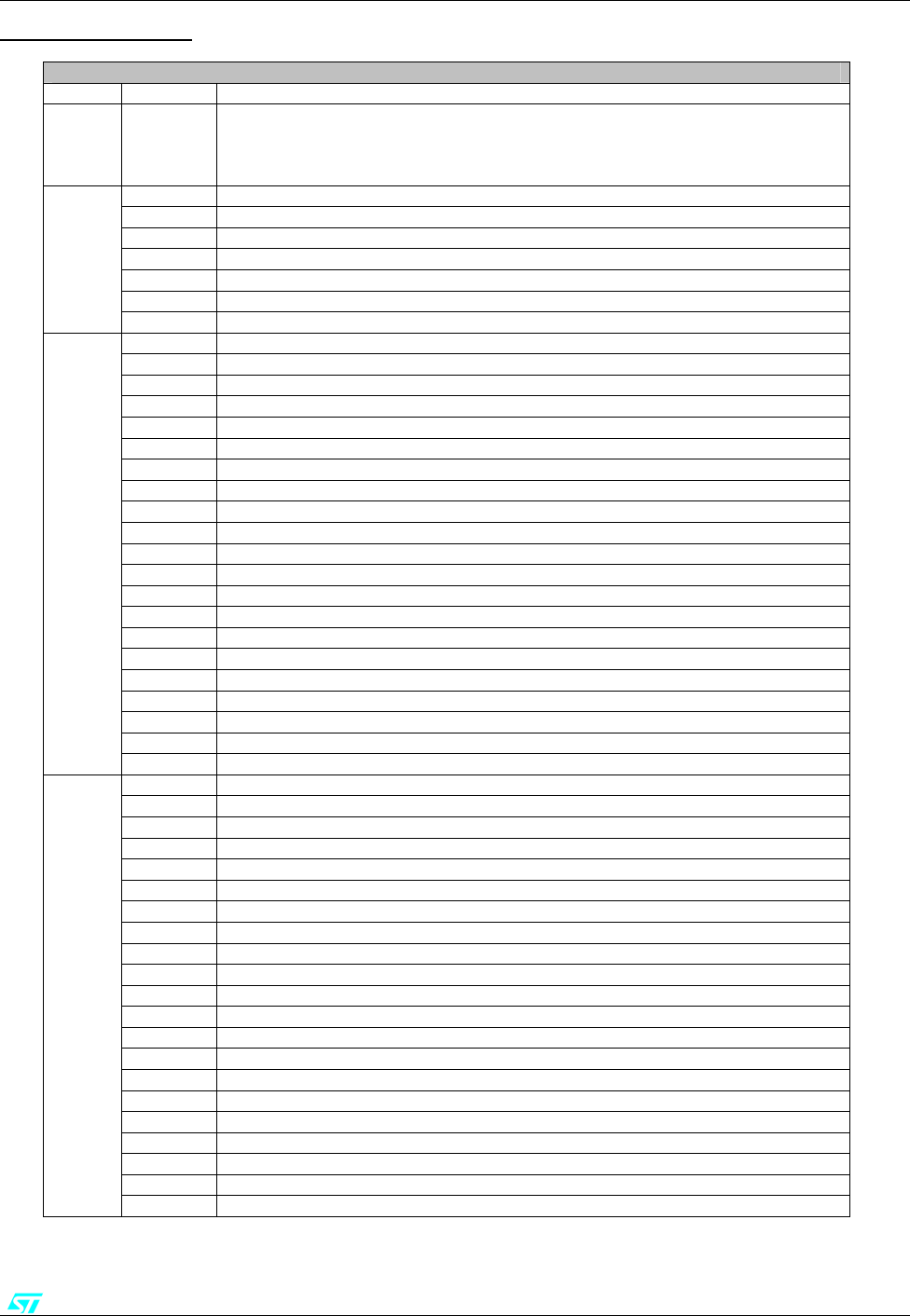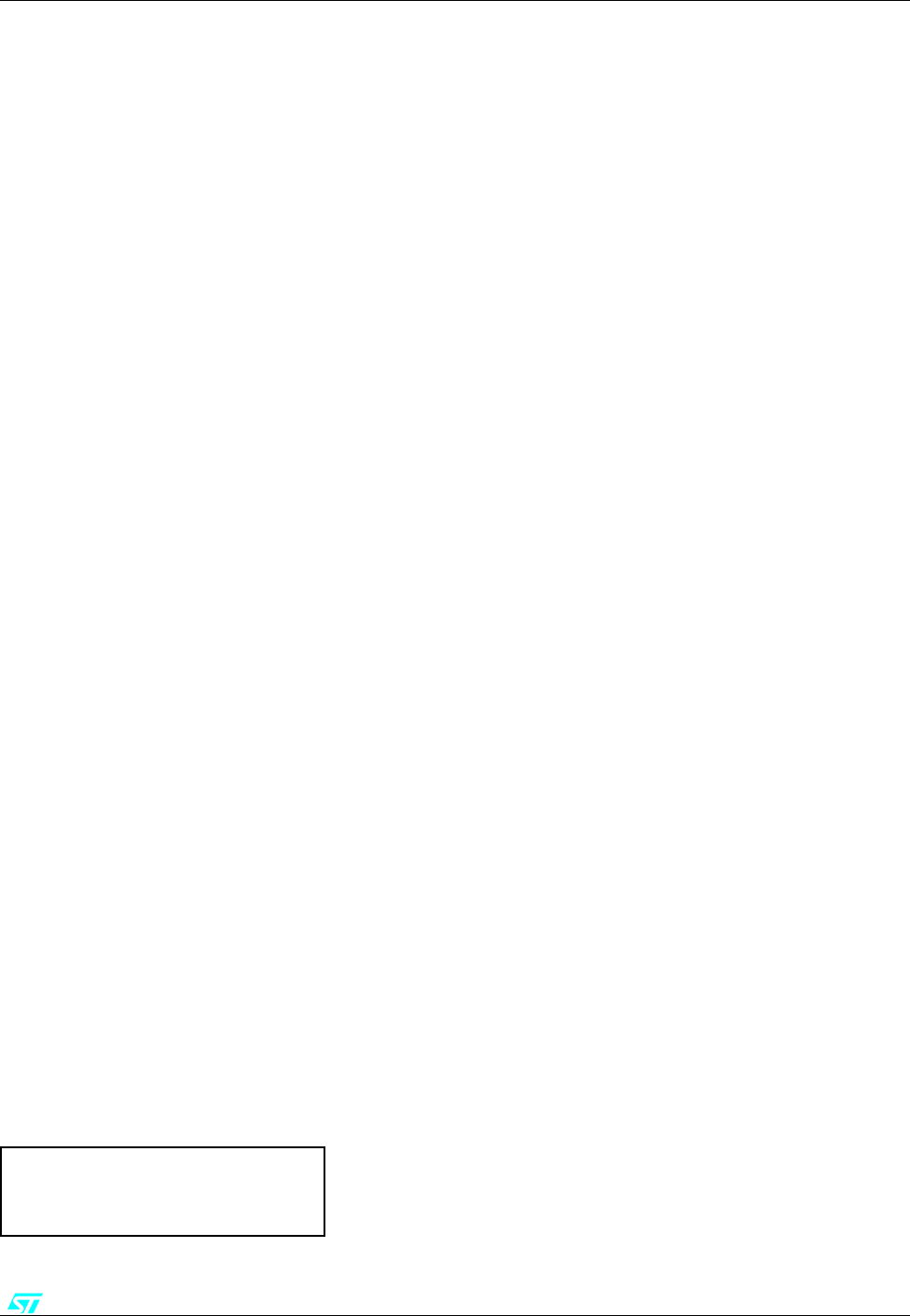ST Microelectronics S R L 2425C2DB Bluetooth class 2 module User Manual SPBT2425C2DBxxx V01
ST Microelectronics S.R.L. Bluetooth class 2 module SPBT2425C2DBxxx V01
Contents
- 1. Users Manual I
- 2. Users Manual II
Users Manual I

SPBT2425C2DB.xxx
User Manual
June 2007
FEATURES
- Bluetooth V2.0 board
- Serial interface on DB9 connector
- USB connection
- PCB antenna on board
- Single 5 V supply voltage
- CE compliant
- FCC compliant
FCC ID: S9N2425C2DB
DESCRIPTION
SPBT2425C2DB.xxx is a Bluetooth Class2 Demoboard for SPBT2425C2 Bluetooth module including the RF antenna.
Suffix xxx identifies the Firmware release : H for HCI commands and AT1 for AT commands.
SPBT2425C2DB.H is a board with a downloaded FW which enables the user to interface the Bluetooth module with HCI
commands.
SPBT2425C2DB.AT1 is a board with a downloaded FW which enables the user to create a Bluetooth link with simple AT
commands.
AT commands are sent by means the serial line which is accessible by the DB9 connector.
SPBT2425C2DB.xxx board can be supplied by an external 5V DC source or via the USB port.
1 - RECOMMENDED OPERATING CONDITIONS
Symbol Parameter Conditions Min Typ Max Unit
VDD Board Supply voltage -20°C < T < 70°C 4 5 6 V
Tstg Operating ambient temperature -20 +70 °C

SPBT2425C2DB.xxx
rev. 1.0 18-Jun-07 2/9
2 - I/O CONNECTIONS
DESCRIPTION
J1 Vcc Power supply plug ( 5V )
J2
USB Port
When the USB port is connected , the 5V USB is used to supply the BT module ( by
means a voltage regulator) and the board itself
When USB port is used 5V on J1 power plug can be avoided
1 USB_DN
2 USB_DP
3 SPI_FRM
4 SPI_CLK
5 SPI_TXD
6 SPI_RXD
J3
7 GND
1 Boot
2 GPIO 0
3 GPIO 1
4 GPIO 2
5 GPIO 3
6 GPIO 4
7 GPIO 5
8 GPIO 6
9 GPIO 7
10 GPIO 8
11 GPIO 9
12 LP_CK
13 GPIO 11
14 GPIO 12
15 GPIO 13
16 GPIO 14
17 GPIO 15
18 1.8V
19 2.8V
20 INHIBIT
J4
21 VDD
1 RX_EN
2 PA_EN
3 PA_V1
4 PA_V0
5 ANT_SW
6 PCM_A
7 PCM_B
8 PCM_SYNC
9 PCM_CLK
10 NTRST
11 TDI
12 TMS
13 TCK
14 TDO
15 13 MHz out
16 RESET
17 INT2
18 RXD
19 TXD
20 I2C0
J5
21 I2C1

SPBT2425C2DB.xxx
rev. 1.0 18-Jun-07 3/9
TP4
C18
C16
C15
J7
1
TP1
C3
R1
S1
R2
C6 TP2
C2
C10
L1
J5 1
21
JP5
1
S2
R3
J1
JP2
1
U1
JP4
1
C9
J3
1
1
7
U2
R4
R8
U4
R7
R6
U3
R5
J2
C17 JP3
1
D1
U5
C12
J4
D2
121
JP1
1
C5
C11
TP3
JP6
1
C7
C8
ANT1
J6
C1
BT1
9
5
6
1
CLASS 1.5 MODULE
C19
R9
R10
L3
C4
L2
DESCRIPTION
J6 Serial line port ( DB9 male connector)
On board is present a level translator to adapt the BT module digital levels to the
RS232 standard levels.
1 Boot signal - If connected to GND the module can perform the dowloading – see also
JP6
J7 2 Reset signal - A low level on this pin force the module in reset state - see also S2
JP1 DB9 connector connection – see electrical drawing
JP2 DB9 connector connection – see electrical drawing
JP3 DB9 connector connection – see electrical drawing
JP4 DB9 connector connection – see electrical drawing
JP5 DB9 connector connection – see electrical drawing
JP6 Boot
If connected to GND the module can perform the dowloading
S1 N.O. push button connected to BT module GPIO3; when activated a Low level is
applied to GPIO6 otherwise GPIO6 is at High level.
S2 Reset – Push button acting on the module reset pin
L1 LED connected to BT module GPIO1 .
L2 LED showing the presence of the 2.8 V internal voltage (2.8 V module version )
L3 LED showing the presence of the 3.3 V internal voltage (3.3 V module version )
3 - BOARD LAYOUT

SPBT2425C2DB.xxx
rev. 1.0 18-Jun-07 4/9
4 - ELECTRICAL DRAWING
only on P.C.B. PC857
GPIO5
S2
SW PUSHBUTTON
TP4
C19
39pF
C6
NM
GPIO3
R4
0 Ohm
C1
22u
6.3V
Vin (3.3V)
RESET
L2
GREEN
J2
USB CON.
1
2
3
4
+2.8V
L1
GREEN
R2
470 Ohm
R1
100K
N.M.
N.M.
+3.3V
U5 LD2985BM28R
Vin 1
GND 2
By Pass
4
Vout
5
INHIBIT 3D1 BYV10-60
R5
0 Ohm
JP3
JUMPER
C15
100n
PC_RTS
JP2
JUMPER
JP4
JUMPER
C16
10u
6.3V
N.M.
R9
470 Ohm
C17
10n
N.M.
GND_RF
+2.8V
C18
22u
6.3V
GND_RF
+2.8V
Vext+5V
+3.3V
C8
100n
+3.3V
N.M.
U4 ST3232
C1- 3
C2+ 4
C2- 5
V- 6
T2out 7
R2in 8
R2out
9T2in
10
GND
15
T1out
14
C1+ 1
T1in
11
V+ 2
R1in
13
R1out
12
Vcc
16
* Only in alternative to C19
C9 100n
N.M.
C10
100n
C7 100n
R6 0 Ohm
N.M.
U2 74V1G66CTR
I/O
1
O/I
2
GND
3C4
Vcc 5
C11
100n
TP1
PC_RX
J1
PLUG
1
3
2
C5
100n
ANT1
BLUETOOTH ANTENNA
JP6
JUMPER
D2
BYV10-60
M_C TS
M_R TS
J6
5
9
4
8
3
7
2
6
1
PC_TX
I1 2.2nH
BOOT
R7 15K
R10
470 Ohm
R8 2.7K
J7
CON2
1
2
U1 LD2985BM33R
Vin 1
GND 2
ByPass
4
Vout
5
INHIBIT 3
USB +5V
NM = NOT MOUNTED
L3
GREEN
GPIO1
R3
100K
FOR INTERNAL FLASH
PROGRAMMING
C12
10n
BT1
BLUETOOTH MODULE SPBT2425
GPIO0
30
GPIO1
31
GPIO2
32
GPIO3
33
GPIO4
34
GPIO5
35
GPIO6_WU
36
GPIO7
37
GPIO8_RES
38
GPIO9
39
GPIO11
41
1.8V
46
GPIO12
42
GPIO13
43
GPIO14
44
GPIO15
45
(JTAG1) TDI 11
(JTAG4) TDO 14
(J TAG2) TMS 12
(JTAG0) NTRST 10
(J TAG3) TC K 13
(I2C_DAT) I2C0 20
(I2C_CLK) I2C1 21
INT2 17
PCM_SY NC 8
PCM_CLK 9
PCM_A 6
PCM_B 7
USB_DN 22
USB_DP 23
(UART1_RX) RXD 18
(UART1_TX) TXD 19
13 MHz out 15
LP_CLK
40
SPI_FRM 24
SPI_CLK 25
SPI_TXD 26
SPI_RXD 27
Vin
49
GND (H.Q.) 28
RESET 16
BOOT
29
GND_RF
51
BT_ANTENNA
52
GND_RF
53
RX_EN 1
PA_EN 2
PA_V1 3
PA_V0 4
ANT_SW 5
2.8V
47
INHIBIT
48
GND
50
J8
SMA
C2
10u
6.3V
GND_RF GND_RF
PC_CTS
PC DTR
JP5
JUMPER
PC DSR
GND_RF
C13
1.2pF
USB (D-)
USB (GND)
TP2
P.C.B. PC856
USB (D+)
USB (Vcc)
J5
CON21
1
2
3
4
5
6
7
8
9
10
11
12
13
14
15
16
17
18
19
20
21
GND
J4
CON21
1
2
3
4
5
6
7
8
9
10
11
12
13
14
15
16
17
18
19
20
21
J3CON7
1
2
3
4
5
6
7
C4
10n
Vin (3.3V)
TP3
U3 USBUF01W6
D1
1GND
2D2
3D3 4
3.3V 5
D4 6
JP1 JUMPER
C3
100n
S1
SW PUSHBUTTON
C14
1.2pF
+3.3V
+3.3V
N.M.

SPBT2425C2DB.xxx
rev. 1.0 18-Jun-07 5/9
5 - DOWNLOADING
SPBT2425C2DB.xxx has also the possibility to be downloaded with a file developed by the user
To download a file into SPBT2425C2DB.xxx the following basics steps must be followed:
- connect the board to a PC by means a RS232 cable connected on COMx port
- put a jumper on JP6 ( Boot pin to low level)
- connect the power supply cable to the board at +5V ext Vin
- open the “Flash loader “ program
- choose UART on Transportation layer section
- choose the appropriate COMx port
- with Browse , choose the firmware file to be downloaded
- Select “Firmware” in both the sections Erase and Download
- If Info Page must be rewritten choose Info Page in Erase and Download sections
- press start : on the dialog bar will appear “ reset the board”
- press S2 (reset) ( a reset is generated) : on the dialog bar will appear the % of the downloading.
- At the end of the downloading a “successful ” or “fail “ message will appear.

SPBT2425C2DB.xxx
rev. 1.0 18-Jun-07 6/9
6 - CERTIFICATIONS
6.1 - CE
Measurements have been performed in accordance with :
EN 300 328 V 1.6.1 (2004-11) : “ Electromagnetic compatibility and radio spectrum Matters (ERM); Wideband Transmission
Systems; Data transmission equipment operating in the 2.4GHZ ISM band and using wide band modulation techniques;
Harmonized EN covering essential requirements under article 3.2 of the R&TTE directive”
EN 301 489-17 V 1.2.1 :2002: “ Electromagnetic compatibility and radio spectrum Matters (ERM); ElectroMagnetic
Compatibility (EMC) standard for radio equipment and services ; Part 17: Specific condition for 2.4GHz wideband transmission
systems and 5 GHz High performance RLAN equipment.”
EN 60950-1 : “Information technology equipment -Safety –Part 1 : General requirements “
6.2 - FCC
To get compliance with FCC CFR47 part15 the following tests have been performed:
CFR47 part 15 section Title Result
15.203 15.247 (b) (4) (i) Antenna requirements pass
15.247 (a) Conducted emission pass
15.209 (a) (f) Radiated emission pass
15.247 (a) Frequency hopping –Spread Spectrum Spec pass
15.247 (b) Maximum Peak Output power pass
15.247 (d) 100 kHz Bandwidth of Frequency Band Edges pass
15.247 (d) Conducted emission pass
15.247 (e) Power Spectral density pass
15.247 (g) FHSS transmission characteristics pass
15.247 (i) (§47CFR1.1307 (b)(1)) RF Humane exposure pass
This board has the following FCC ID:
FCC ID:S9N2425C2DB

SPBT2425C2DB.xxx
rev. 1.0 18-Jun-07 7/9
FCC Statement
This device complies with Part 15 of the FCC Rules. Operation is subject to the following two conditions:
(1) this device may not cause harmful interference, and (2) this device must accept any interference received, including
interference that may cause undesired operation.
NOTE: This equipment has been tested and found to comply with the limits for a Class B digital device, pursuant to Part 15 of
the FCC Rules. These limits are designed to provide reasonable protection against harmful interference in a residential
installation. This equipment generates, uses and can radiate radio frequency energy and, if not installed and used in accordance
with the instructions, may cause harmful interference to radio communications.
However, there is no guarantee that interference will not occur in a particular installation.
If this equipment does cause harmful interference to radio or television reception, which can be determined by turning the
equipment off and on, the user is encouraged to try to correct the interference by one or more of the following measures:
- Reorient or relocate the receiving antenna
- Increase the separation between the equipment and receiver
- Connect the equipment into an outlet on a circuit different from that to which the receiver is connected
Consult the dealer or an experienced radio/TV technician for help.
Antenna
Our board type SPBT2425C2DB.xxx is for OEM integrations only. The end-user product will be
professionally installed in such a manner that only the authorized antennas are used.
Caution
Any changes or modifications not expressed approved by the party responsible for compliance could cause the module to cease
to comply with FCC rules part 15, and thus void the user’s authority to operate the equipment.
Label instruction
INSTRUCTION MANUAL FOR FCC ID LABELING
Module type : Bluetooth class 2 board SPBT2425C2DB.xxx ( SPBT2425C2 module
+ PC856 carrier board)
FCC-ID : S9N2425C2DB
This intends to inform you how to specify the FCC ID of our Bluetooth board SPBT2425C2DB on your final
product.
Based on the Public Notice from FCC, the product into which our transmitter module is installed must display a
label referring to the enclosed module.
The label should use wording such as “Contains Transmitter module FCC ID: S9N2425C2DB or “Contains FCC ID:
S9N2425C2DB, any similar wording that expressed the same meaning may be use.
It shows an example below
Contains FCC ID: S9N2425C2DB

SPBT2425C2DB.xxx
rev. 1.0 18-Jun-07 8/9
Special requirement for Modular application
The following requirements are fulfilled:
1) The modular transmitter must have its own RF shielding:
The RF module used on the board fulfils the emission requirements of the FCC rules without additional shielding.
2) The modular transmitter must have buffered modulation/data inputs:
The module has a memory management unit inside of the IC. The processor interfacing with the external application by means
general purpose I/O ( GPIO) , Uart, USB, PCM, I2C, SPI. The processor interfaces also the RF part of the module exchanging
data and command with it. Inside the processor a flash memory is available to download the customer application and the
Bluetooth profiles.
3) The modular transmitter must have its own power supply regulation:
The module contains an own voltage regulation. In case of changes in the supply voltage VCC (for example caused by
temperature changes or other effects), the internal voltage will be stabilized.
4) The modular transmitter must comply with the antenna requirements of Section 15.203 and 15.204:
The RF module is for OEM (Original Equipment Manufacturer) integration only. The end-user product will be professionally
installed in such a manner that only the authorized antenna is used.
5) The modular transmitter must be tested in a stand-alone configuration:
The RF module was tested in a stand-alone configuration.
6) The modular transmitter must be labelled with its own FCC ID number:
The RF module will be labelled with its own FCC ID number. When the module is installed inside the end-product, the label is
not visible. The OEM manufacturer is instructed how to apply the exterior label.
7) The modular transmitter must comply with any specific rule or operating requirements applicable to the transmitter and the
manufacturer must provide adequate instructions along with the module to explain any such requirements:
The EUT is compliant with all applicable FCC rules. Detail instructions are given in the product Users Guide.
8) The modular transmitter must comply with any applicable RF exposure requirements.
- Maximum measured power output: 2,33 mW
- Maximum antenna gain: 1 dBi = numeric gain 1,259 (see also FCC test report)
Maximum permissible exposure defined in 47 CFR 1.1310: 1 mW/cm².
The RF module operates at low power level so it does not exceed the Commission’s RF exposure guidelines limits; furthermore,
Spread spectrum transmitters operate according to the Section 15.247 are categorically excluded from routine environmental
evaluation.

SPBT2425C2DB.xxx
rev. 1.0 18-Jun-07 9/9
Information furnished is believed to be accurate and reliable. However, STMicroelectronics assumes no responsibility for the consequences of use of
such information nor for any infringement of patents or other rights of third parties which may result from its use. No license is granted by implication
or otherwise under any patent or patent rights of STMicroelectronics. Specifications mentioned in this publication are subject to change without
notice. This publication supersedes and replaces all information previously supplied. STMicroelectronics products are not authorized for use as critical
components in life support devices or systems without express written approval of STMicroelectronics.
The ST logo is a registered trademark of STMicroelectronics
© 2007 STMicroelectronics - All Rights Reserved
STMicroelectronics GROUP OF COMPANIES
Australia - Brazil - China - Finland - France - Germany - Hong Kong - India - Italy - Japan - Malaysia - Malta - Morocco
Singapore - Spain - Sweden - Switzerland - United Kingdom - U.S.A.
http://www.st.com